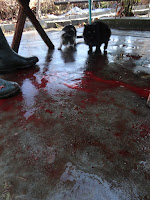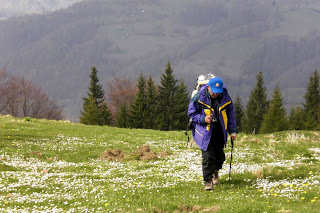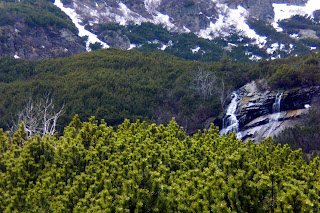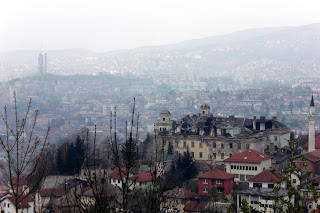Part 1:
Part 2:
Merry Christmas!
 |
| Grandma cleaning out the intestines. |
 |
 |
| Panorama from the top of the hill at the planting in Lesmir |
 The Lesmir trip was only the start of the planting season and
it created a team that would come back together as a whole for the final planting
in Marsani. Many of the Lesmir
coordinators were involved in the plantings in between the first and the last
as well. All in all, MMV organized seven
tree planting activities in the fall of 2011 addressing one of their goals of
the reforesting Romania. At the final
and largest planting of the season an impressive 37,000+ trees were planted in
an area that you could play beach volleyball on. We were not planting in soil, it was
sand. Riding the bus away from the
planting site you could see large plots of trees planted in the same ground a
few years earlier taking nicely to the soil. Plus, the trees planted were one of my favorites
found in Romania, the acacia tree. Seeing
the before and after, and the realization that a forest was just planted was a
very rewarding aspect of the project, but certainly not the most rewarding
aspect. Meeting, working with, and
getting to know the coordinators was by far the most valuable reward that I
gained in this project. For that I thank
MaiMultVerde. For the coordinators themselves,
maybe it was the trees and realizing the positive impact that they can make,
maybe it was the smiling faces and the interesting stories of the volunteers
they coordinated, or maybe it was getting to know the other coordinators a bit
better. If one of the coordinators
happens to read this I kindly ask them to leave their perspectives in the
comment section below.
The Lesmir trip was only the start of the planting season and
it created a team that would come back together as a whole for the final planting
in Marsani. Many of the Lesmir
coordinators were involved in the plantings in between the first and the last
as well. All in all, MMV organized seven
tree planting activities in the fall of 2011 addressing one of their goals of
the reforesting Romania. At the final
and largest planting of the season an impressive 37,000+ trees were planted in
an area that you could play beach volleyball on. We were not planting in soil, it was
sand. Riding the bus away from the
planting site you could see large plots of trees planted in the same ground a
few years earlier taking nicely to the soil. Plus, the trees planted were one of my favorites
found in Romania, the acacia tree. Seeing
the before and after, and the realization that a forest was just planted was a
very rewarding aspect of the project, but certainly not the most rewarding
aspect. Meeting, working with, and
getting to know the coordinators was by far the most valuable reward that I
gained in this project. For that I thank
MaiMultVerde. For the coordinators themselves,
maybe it was the trees and realizing the positive impact that they can make,
maybe it was the smiling faces and the interesting stories of the volunteers
they coordinated, or maybe it was getting to know the other coordinators a bit
better. If one of the coordinators
happens to read this I kindly ask them to leave their perspectives in the
comment section below.  If you wish to donate to future tree plantings you can
donate here. Ten RON ($3) plants 1 small
tree.
If you wish to donate to future tree plantings you can
donate here. Ten RON ($3) plants 1 small
tree.  The slow riding ends when approached with hazard number
4. Ever since bike riding began in
Bucharest hazard number 4 has haunted nearly anyone who dares to take to the small
streets on two wheels. There came a
point when I finally found my perfect route to work. The route took a relatively straight path, it
stuck to the small streets, and it kept me out of high traffic areas, both foot
and vehicle traffic. The one thing that caused
me to change that perfect course was that one dog, near that one block, always waiting
there to chase me down the street. Luckily
I found a decent detour that allows me to avoid the dog without significantly
changing my course.
The slow riding ends when approached with hazard number
4. Ever since bike riding began in
Bucharest hazard number 4 has haunted nearly anyone who dares to take to the small
streets on two wheels. There came a
point when I finally found my perfect route to work. The route took a relatively straight path, it
stuck to the small streets, and it kept me out of high traffic areas, both foot
and vehicle traffic. The one thing that caused
me to change that perfect course was that one dog, near that one block, always waiting
there to chase me down the street. Luckily
I found a decent detour that allows me to avoid the dog without significantly
changing my course. 








 't want to spend all day in the rain. Admittedly I was a bit worried about the rain, but rain alone is no good reason to stay off the mountain. It ended up being a somewhat cloudy but mostly sunny day. The best part of the Lacul Mija hike is when you round the corner to the back side of Carja peak. In that small valley the city, the pollution, the people, and the ski area all disappear. Nature’s stereo pumps the greatest hits of the spring below whose rushing waters come from nowhere it seems. Mija peak forms a bowl with just a bit of water in its center. That bowl can be seen when looking at Parang from Petrila. What can't be seen from that part of the hike are the Dacias, the maxi-taxi's, and the train, the second-hand stores, the restaurants, and the blocks, the buna ziua, ceau, and la revedere. These are all things that I've come to love in Romania but an occasional escape is a necessary part of any relationship. Like the first time on that open trail between peaks, Ernest was the guide. Unlike the first time I decided not to enter the near freezing temperatures of the lake.
't want to spend all day in the rain. Admittedly I was a bit worried about the rain, but rain alone is no good reason to stay off the mountain. It ended up being a somewhat cloudy but mostly sunny day. The best part of the Lacul Mija hike is when you round the corner to the back side of Carja peak. In that small valley the city, the pollution, the people, and the ski area all disappear. Nature’s stereo pumps the greatest hits of the spring below whose rushing waters come from nowhere it seems. Mija peak forms a bowl with just a bit of water in its center. That bowl can be seen when looking at Parang from Petrila. What can't be seen from that part of the hike are the Dacias, the maxi-taxi's, and the train, the second-hand stores, the restaurants, and the blocks, the buna ziua, ceau, and la revedere. These are all things that I've come to love in Romania but an occasional escape is a necessary part of any relationship. Like the first time on that open trail between peaks, Ernest was the guide. Unlike the first time I decided not to enter the near freezing temperatures of the lake. orm for a bit. Dragos came out with us for the concert and there we were, one American, one Romanian, and a bunch of Moldavians eagerly awaiting the evening’s musical entertainment. That entertainment consisted of a lot of dj, dancing, lip sinking music before the headliner Zdob si Zdub came on. I first saw Zdob si Zdub at Peninsula in August and the music instantly took me back to my punk rock fan days. The high energy rock mixed with cultural music reminded me of the ska and irish punk rock bands that I used to catch at the Vans Warped Tour. Most people I know in Petrosani are more into the dj kind of music so it was nice to be there jumping up and down to some good rock music with the Moldavians who were appreciating one of their own bands far from home. Like the students I was hanging with, Zdob si Zdub are from the Republic of Moldova.
orm for a bit. Dragos came out with us for the concert and there we were, one American, one Romanian, and a bunch of Moldavians eagerly awaiting the evening’s musical entertainment. That entertainment consisted of a lot of dj, dancing, lip sinking music before the headliner Zdob si Zdub came on. I first saw Zdob si Zdub at Peninsula in August and the music instantly took me back to my punk rock fan days. The high energy rock mixed with cultural music reminded me of the ska and irish punk rock bands that I used to catch at the Vans Warped Tour. Most people I know in Petrosani are more into the dj kind of music so it was nice to be there jumping up and down to some good rock music with the Moldavians who were appreciating one of their own bands far from home. Like the students I was hanging with, Zdob si Zdub are from the Republic of Moldova. 
 as a ridge across the valley that climbed up to a saddle eventually leading to Romania's fifth highest peak. You could look across and see where the pine forests ended opening up to an alpine meadow. Lying back on that grassy wall I could feel the warm morning sun on my face. There aren’t many better places to be at 11:00am on a Saturday morning.
as a ridge across the valley that climbed up to a saddle eventually leading to Romania's fifth highest peak. You could look across and see where the pine forests ended opening up to an alpine meadow. Lying back on that grassy wall I could feel the warm morning sun on my face. There aren’t many better places to be at 11:00am on a Saturday morning. hard hiking and we exited the juniper on the right of the waterfall in a small open spot in the forest. Doamna G went ahead and we witnessed her from far away as she searched for a trail and eventually climbed up a rock face disappearing back into the Juniper forest above the waterfall. We decided to follow. The rock face was fun to climb. Even though the juniper was hard to climb through even the smallest of branches will bend without breaking. You can count on them to resist as you pull up through them at the top of a steep rock wall. Unfortunately the rock led straight into an even thicker section of juniper. Eventually we found an open spot were we could sit, rest, and declare defeat before turning back.
hard hiking and we exited the juniper on the right of the waterfall in a small open spot in the forest. Doamna G went ahead and we witnessed her from far away as she searched for a trail and eventually climbed up a rock face disappearing back into the Juniper forest above the waterfall. We decided to follow. The rock face was fun to climb. Even though the juniper was hard to climb through even the smallest of branches will bend without breaking. You can count on them to resist as you pull up through them at the top of a steep rock wall. Unfortunately the rock led straight into an even thicker section of juniper. Eventually we found an open spot were we could sit, rest, and declare defeat before turning back. the way up. We decided to ride the hill a little further away from the stream before descending. It was a steep, fast descent and we passed a viper on the way down. We were able to get close to the viper and take pictures. Apparently they don't bite if it’s cold. Walking that last 45 minutes of an easy downward slope, the rubbery sensation of muscles used all day long kicked in. It wasn't so hard to fall asleep later that night.
the way up. We decided to ride the hill a little further away from the stream before descending. It was a steep, fast descent and we passed a viper on the way down. We were able to get close to the viper and take pictures. Apparently they don't bite if it’s cold. Walking that last 45 minutes of an easy downward slope, the rubbery sensation of muscles used all day long kicked in. It wasn't so hard to fall asleep later that night. e poverty visible from the train while leaving Belgrade was unseen as we pulled into Sarajevo, though the destruction caused by the war was already visible.
e poverty visible from the train while leaving Belgrade was unseen as we pulled into Sarajevo, though the destruction caused by the war was already visible. s. It was significantly warmer in Mostar than in Sarajevo. The sun was shining as we strolled over old stone streets through a courtyard of a mosque and a bazaar. Finally the view opened up to show the famous bridge (stari most) in the center of the old city. It was a stunning sight connecting two rock fortresses hanging high above the fast flowing water of the Neretva River. In a couple of locations I found stones with the phrase "Don't Forget" painted on them referring to the 1993 destruction of the bridge by the Croatian Defense Counsel. I wonder why I only saw it painted in English and not say... Croatian, Bosnian, or Serbian. After some Cevapi for lunch we went down to the water where we found a rock to relax on, dip our feet in, and admire the bridge from below. After more roaming, a drink, and watching a man jump from the high bridge we made our way back to the bus station to conclude our day trip to Mostar.
s. It was significantly warmer in Mostar than in Sarajevo. The sun was shining as we strolled over old stone streets through a courtyard of a mosque and a bazaar. Finally the view opened up to show the famous bridge (stari most) in the center of the old city. It was a stunning sight connecting two rock fortresses hanging high above the fast flowing water of the Neretva River. In a couple of locations I found stones with the phrase "Don't Forget" painted on them referring to the 1993 destruction of the bridge by the Croatian Defense Counsel. I wonder why I only saw it painted in English and not say... Croatian, Bosnian, or Serbian. After some Cevapi for lunch we went down to the water where we found a rock to relax on, dip our feet in, and admire the bridge from below. After more roaming, a drink, and watching a man jump from the high bridge we made our way back to the bus station to conclude our day trip to Mostar.